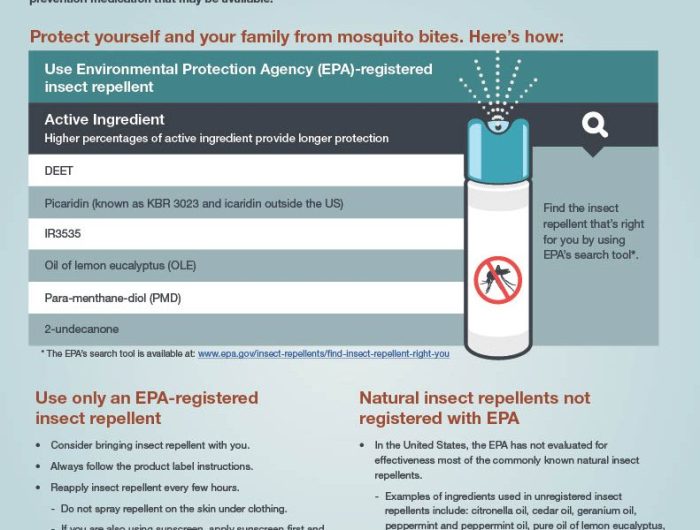How to prevent mosquito bites is a crucial topic for anyone spending time outdoors. Mosquitoes are more than just a nuisance; they can transmit serious diseases. This guide delves into the science behind mosquito behavior, their breeding habits, and effective prevention strategies. We’ll cover everything from identifying mosquito habitats to personal protection and community-wide control efforts, ensuring you’re well-equipped to protect yourself and your loved ones.
From understanding the ideal breeding grounds for these pesky insects to recognizing their favorite biting times, this guide offers a comprehensive approach to mosquito prevention. We’ll explore effective strategies for personal protection, from choosing the right clothing and repellents to mastering safe travel tactics.
Identifying Mosquito Habitats
Mosquitoes, those tiny yet persistent pests, aren’t just randomly buzzing around. They need specific environments to breed, and understanding these habitats is crucial for effective mosquito control. Knowing where mosquitoes lay their eggs allows us to target their breeding grounds, significantly reducing their populations and the risk of mosquito-borne diseases.Mosquitoes prefer standing water, where their eggs can develop into larvae and eventually into biting adults.
The ideal breeding grounds vary based on climate and local conditions. Understanding these nuances can help you identify and eliminate potential breeding sites in your own area.
Common Mosquito Breeding Grounds
Mosquitoes thrive in a variety of water sources. These range from the obvious, like stagnant puddles, to less obvious locations, like neglected flowerpots. The key factor is standing water that provides the perfect environment for mosquito eggs to hatch and develop.
Examples of Mosquito Breeding Sites
Various breeding sites exist depending on the environment and climate. In arid regions, even small, temporary pools of water collected in tree holes or discarded containers can support mosquito populations. Conversely, in humid regions, stagnant water in flowerpots, discarded tires, and clogged gutters can become significant breeding grounds. Rain barrels, if not properly covered, can also become breeding havens.
Factors Influencing Mosquito Breeding
Several factors influence the prevalence of mosquito breeding sites. Temperature, rainfall, and humidity play a crucial role in the development cycle of the mosquito. Additionally, the presence of organic matter in standing water accelerates the growth of mosquito larvae. Furthermore, the proximity to human settlements often correlates with the abundance of breeding sites. The presence of vegetation also provides cover for mosquitoes, influencing their ability to breed and thrive in an area.
Comparison of Mosquito Breeding Environments
| Breeding Environment | Description | Climate Suitability | Preventive Measures |
|---|---|---|---|
| Stagnant Puddles | Shallow pools of water, often found in yards, parks, or construction sites. | Various climates | Empty, drain, or cover the puddles. |
| Flower Pots | Water collected in flower pots, especially those not regularly emptied. | Various climates | Regularly empty and clean flower pots. |
| Tires | Discarded tires that collect water, forming breeding grounds. | Various climates | Remove or properly store tires. |
| Gutters | Clogged gutters that accumulate water. | Various climates | Clear gutters regularly. |
| Rain Barrels | Rainwater collected in barrels, often uncovered. | Various climates | Cover rain barrels or use mosquito dunks. |
Preventive Measures to Eliminate Breeding Grounds
Regularly inspecting and eliminating potential breeding sites is essential in controlling mosquito populations. This proactive approach significantly reduces the risk of mosquito bites and mosquito-borne diseases.
- Regularly Empty and Clean Containers: Empty and scrub containers, such as flower pots, buckets, and old tires, to remove any standing water. Inspect regularly for any signs of water accumulation.
- Maintain Proper Drainage: Ensure proper drainage in your yard to prevent water from accumulating in low-lying areas. Repair any cracks or holes in your gutters to ensure proper water runoff.
- Cover Water Sources: Cover water storage containers, such as rain barrels and water tanks, to prevent mosquitoes from laying eggs.
- Eliminate Standing Water: Regularly check for and eliminate any standing water in your yard, including puddles, birdbaths, and other small water collections.
- Maintain Cleanliness: Keep your surroundings clean to prevent the accumulation of organic matter in water sources, which can accelerate mosquito breeding.
Understanding Mosquito Behavior
Mosquitoes, those tiny blood-sucking pests, are far more than just a nuisance. Understanding their behavior is crucial for effective prevention strategies. Their flight patterns, preferences for certain times of day, and attraction to specific stimuli all play a vital role in avoiding bites. Knowing what draws them in, how they move, and the differences in their behavior between species can significantly reduce your risk of encountering them.
Attraction Factors
Mosquitoes are attracted to a variety of factors. Their primary goal is to find a suitable host to feed on, and various environmental cues help them achieve this. These cues are often interconnected and can amplify each other, increasing the risk of bites.
- Carbon Dioxide (CO 2): Humans exhale CO 2, which mosquitoes can detect from a considerable distance. The more CO 2, the greater the attraction. Active individuals produce more CO 2, making them more appealing targets.
- Body Heat: Mosquitoes are highly sensitive to changes in temperature. They are drawn to warmer bodies, including humans and animals. This is often combined with the higher CO 2 levels produced by active bodies.
- Body Odor: Mosquitoes possess olfactory receptors that detect volatile organic compounds (VOCs) emitted from human skin. These VOCs, which are unique to each individual, can play a significant role in attracting or repelling mosquitoes. Certain odors, such as lactic acid from sweat, are particularly appealing.
- Clothing Color: Darker colors absorb more heat than lighter colors, making them more attractive to mosquitoes. This effect is often combined with the presence of CO 2 and body heat.
- Humidity and Water Sources: Mosquitoes thrive in humid environments and often congregate around standing water sources, which serve as breeding grounds. Proximity to these sources increases the chance of encounters.
Mosquito Flight Patterns and Behavior
Mosquitoes exhibit various flight patterns depending on the species and environmental conditions. Understanding these patterns can help anticipate their movements and avoid bites.
- Flight Range: The flight range of a mosquito is generally limited to a few kilometers, but their flight patterns can vary based on factors such as wind direction, temperature, and humidity. Strong winds can carry them further, and their flight speed can be relatively fast.
- Attraction to Light: Some mosquito species are attracted to light sources. This behavior is often observed at night, and the attraction can vary based on the intensity and type of light source.
- Landing Preferences: Different species have different landing preferences, which might be influenced by their specific feeding habits. Some species prefer certain body parts or clothing types.
Biting Habits of Different Species
Mosquitoes vary in their biting habits, reflecting their diverse feeding strategies and preferences. This variation is often linked to the species’ life cycle and the availability of food sources.
- Feeding Patterns: Some species are active during the day, while others prefer to bite at night. The timing of their activity is often influenced by the availability of hosts.
- Species-Specific Preferences: Different mosquito species have varying preferences for their hosts, including humans and animals. Some species are known to preferentially target certain types of animals, whereas others may have a broader range of hosts.
- Geographical Distribution: The biting habits of mosquitoes can also be influenced by their geographical location. Environmental conditions, host availability, and the presence of breeding grounds can impact the behavior of different mosquito species in various regions.
Best Times of Day for Mosquito Activity
Mosquito activity is often influenced by environmental factors such as temperature and humidity. Understanding the peak activity times allows for effective avoidance strategies.
- Dusk and Dawn: Mosquitoes are often most active during dusk and dawn, as these periods often coincide with peak temperatures and high humidity. This behavior is a result of their evolutionary adaptations to find hosts.
- Early Morning and Late Evening: Mosquitoes can also be active in the early morning and late evening, depending on the species and environmental conditions.
Identifying Mosquito Species
Accurate identification of the mosquito species is crucial for effective control measures. Several characteristics can be used to distinguish between different types.
- Body Shape and Size: The overall shape and size of the mosquito’s body, including its legs and wings, can be helpful identifiers. Species-specific variations exist, which help differentiate between different types.
- Color and Pattern: The color and pattern on the mosquito’s body can be helpful in identification. Variations exist between species and are useful tools in identification.
- Wing Veins and Structure: The presence and pattern of wing veins can be diagnostic for specific species. Detailed examination can help identify particular species.
Protective Clothing and Equipment
Protecting yourself from mosquito bites goes beyond just repellents. Choosing the right clothing and gear can significantly reduce your exposure to these pesky insects. Understanding the types of materials and their effectiveness is key to maximizing your protection, especially during outdoor activities.Mosquitoes are attracted to different fabrics and colors to varying degrees. Proper clothing selection can act as a physical barrier, reducing the opportunities for mosquitoes to land and bite.
This is particularly crucial in high-risk areas or during peak mosquito activity times.
Clothing Materials for Mosquito Protection
Understanding the types of fabrics that offer the best mosquito protection is important. Natural fibers often provide better protection than synthetic ones.
- Natural Fibers: Materials like linen, cotton, and wool, when woven tightly, can create a barrier to mosquito bites. Their natural texture and weave patterns can help prevent mosquitoes from piercing the fabric.
- Synthetic Fabrics: While some synthetic fabrics, like nylon or polyester, may be breathable, they may not offer the same level of protection as tightly woven natural fibers. Their smooth surfaces can sometimes make it easier for mosquitoes to land and bite. However, some modern synthetic fabrics are treated to provide enhanced mosquito resistance.
- Waterproof and Moisture-Wicking Fabrics: These fabrics, often used in outdoor gear, can offer additional protection against mosquitoes. The water resistance and breathability of these materials can make them a practical choice in humid environments. The tightness of the weave is still a crucial factor in preventing mosquito bites.
Examples of Protective Clothing for Outdoor Activities, How to prevent mosquito bites
Selecting the appropriate clothing for outdoor activities is vital. The best protection is often a combination of multiple layers and fabrics.
- Hiking: Tightly woven long-sleeved shirts and long pants made of natural fibers like linen or cotton are ideal for hiking trips. Consider adding a light, breathable jacket for extra protection and warmth.
- Camping: Similar to hiking, long sleeves and pants are recommended for camping. Consider using a light, waterproof jacket and pants to protect against rain and provide an additional layer of defense.
- Fishing: Lightweight, quick-drying fabrics are preferred for fishing. Long sleeves and pants, or convertible trousers that can be quickly adjusted, are useful. Consider using permethrin-treated clothing for extra protection.
Mosquito Nets and Screens
Mosquito nets and screens provide an effective barrier against mosquitoes in various settings.
- Mosquito Nets: These are commonly used for beds or porches to prevent mosquitoes from entering. They come in various materials, ranging from lightweight nylon to more durable polyester. The mesh size plays a significant role in the effectiveness of the net.
- Window Screens: Screens installed on windows and doors are essential for keeping mosquitoes out of homes and other buildings. They can be made from various materials, including aluminum or plastic mesh. Ensure the screens are tightly fitted to prevent gaps where mosquitoes can enter.
Effectiveness Comparison of Clothing Fabrics
A comparison table can illustrate the effectiveness of different clothing fabrics in deterring mosquito bites.
| Fabric | Mosquito Bite Prevention Effectiveness | Pros | Cons |
|---|---|---|---|
| Tightly Woven Cotton | High | Breathable, comfortable | Can be heavier than some synthetics |
| Permethrin-Treated Nylon | Very High | Durable, water-resistant | Can be less breathable |
| Polyester | Medium | Lightweight, quick-drying | Can be less protective than tightly woven fabrics |
| Linen | High | Breathable, natural | Can wrinkle easily |
Mosquito Repellent Clothing: Benefits and Drawbacks
Permethrin-treated clothing can provide long-lasting protection against mosquitoes.
Mosquito repellent clothing, often treated with permethrin, offers significant protection.
Keeping those pesky mosquitoes away is crucial for a comfortable summer. Using repellent, wearing long sleeves and pants, and eliminating standing water are all great preventative measures. But, for those interested in a more holistic approach to health and well-being, considering the features of a fitness tracker like the Oura Ring vs apple watch can also help you understand your body’s rhythms, which could indirectly affect mosquito activity, and help you make better decisions for preventing bites.
For a deeper dive into the comparison of these devices, check out this helpful guide on oura ring vs apple watch. Ultimately, staying proactive and informed is key to mosquito bite prevention.
- Benefits: Permethrin-treated clothing can offer extended protection, lasting for multiple washes. This reduces the need for frequent repellent applications. It can be a convenient solution for extended outdoor activities.
- Drawbacks: Permethrin can be harmful to pets and some people may have allergic reactions. Proper handling and care instructions must be followed.
Mosquito Repellents and Treatments
Mosquitoes are persistent pests, and keeping them away is a crucial part of enjoying outdoor activities. Effective mosquito repellent strategies involve understanding the various types of repellents, their mechanisms, and the safest ways to use them. Choosing the right repellent and applying it correctly can significantly reduce your risk of bites and associated illnesses.
Active Ingredients in Common Repellents
Common mosquito repellents contain active ingredients that deter mosquitoes. These ingredients work by interfering with the mosquito’s sensory perception or by creating a barrier that prevents the mosquito from landing on the skin. The most common active ingredients include DEET, picaridin, IR3535, and oil of lemon eucalyptus. Understanding these ingredients and their mechanisms is essential for choosing the right repellent for your needs.
Effectiveness and Safety of Repellent Types
Different repellent types offer varying degrees of effectiveness and safety profiles. DEET is generally considered the most effective, but its high concentration can be irritating to some individuals. Picaridin and IR3535 are often seen as good alternatives for people sensitive to DEET. Oil of lemon eucalyptus, while effective, should be used with caution, especially on children. Always consult product labels for specific usage instructions and safety information.
Comparison of Repellent Application Methods
The way you apply a repellent significantly impacts its effectiveness. Spraying the repellent directly onto exposed skin is a common method. However, some people prefer applying the repellent onto clothing or using a repellent stick or lotion. Proper application methods ensure that the repellent is evenly distributed and provides optimal protection. For instance, spraying the repellent onto clothing before going outside, and then reapplying it after sweating, will give better protection.
Safe and Effective Homemade Mosquito Repellent Recipes
Natural repellents can be a safer alternative for some individuals. These recipes often utilize essential oils known for their mosquito-repelling properties. While some homemade recipes may offer a natural approach, they might not be as effective as commercially available repellents. Effectiveness varies depending on the ingredients and the person.
- Lemon Eucalyptus Oil: Combine a few drops of lemon eucalyptus oil with a carrier oil (like coconut or almond oil) and apply it to exposed skin. Caution: Avoid contact with eyes and mouth.
- Lavender Oil: Lavender oil is known for its pleasant scent and potential mosquito-repelling properties. Mix a few drops with a carrier oil for topical application.
- Citronella Oil: Citronella oil is another commonly used natural repellent. It can be diluted in a carrier oil or used in a candle or burner.
Proper Repellent Application and Precautions
Proper application ensures the repellent provides maximum protection and minimizes risks. Follow the manufacturer’s instructions for dosage and application frequency. Avoid applying repellent to broken skin or irritated areas. Reapply the repellent as needed, especially after sweating or swimming. Remember to store repellents in a cool, dry place and out of reach of children.
Personal Protection Strategies

Mosquito bites can be more than just a minor annoyance; they can transmit diseases. Taking proactive steps to protect yourself is crucial, especially in areas where mosquitoes are prevalent. This section delves into practical strategies for preventing bites during outdoor activities and travel, as well as specific approaches for high-risk environments.Effective mosquito bite prevention involves a multi-pronged approach.
It’s not just about applying repellent; it’s about understanding your environment, your habits, and the mosquitoes themselves. By combining knowledge and careful practices, you can significantly reduce your risk of encountering these pesky insects.
Avoiding Mosquito Bites During Outdoor Activities
Outdoor activities are a great way to enjoy nature, but mosquitoes can quickly spoil the fun. Knowing where mosquitoes thrive and what they are attracted to is key to minimizing the risk. Choosing the right time of day to be outdoors can make a huge difference. Dusk and dawn are peak biting times for many mosquito species.
Scheduling outdoor activities for other times can significantly reduce exposure.
- Wear long sleeves and pants to create a physical barrier between your skin and the insects. Light-colored clothing can also help, as mosquitoes are more attracted to darker colors.
- Utilize mosquito netting over beds or during outdoor sleep. This is particularly helpful in high-risk areas.
- Ensure proper ventilation and drainage around your home and recreational areas. Mosquitoes breed in standing water; eliminating these breeding grounds is a significant preventative measure.
- Be mindful of the weather. High humidity and warm temperatures create favorable conditions for mosquito breeding and activity.
Mosquito-Safe Travel Strategies
Traveling to areas with high mosquito populations requires a more comprehensive approach to prevention. This involves planning ahead, utilizing effective repellents, and being aware of local conditions.
Keeping those pesky mosquitoes away is crucial for a peaceful evening. Wearing long sleeves and pants is a great start, and using mosquito repellent is a must. Interestingly, some studies suggest that increasing melanin production in your skin might also play a role in mosquito bite prevention, as darker skin might be less attractive to them. For more information on how to increase melanin , check out this helpful guide.
Ultimately, a combination of these strategies will help you enjoy your outdoor time bite-free.
- Research the destination thoroughly. Understand the local mosquito species, their biting patterns, and any potential health risks associated with mosquito bites in that region.
- Pack mosquito repellent with high concentrations of active ingredients. Consider using DEET, picaridin, or oil of lemon eucalyptus, and choose the appropriate concentration based on the severity of the mosquito problem.
- Consult your doctor before traveling. Discuss potential health risks and any necessary precautions, such as vaccinations or medication.
- Avoid areas known to be mosquito breeding grounds, such as stagnant water or dense vegetation.
Strategies for High Mosquito Population Areas
In areas with high mosquito populations, proactive measures are crucial. Understanding mosquito behavior and adapting your activities accordingly is paramount.
- Apply repellent liberally and frequently, especially during peak biting times. Follow the instructions on the product label carefully.
- Maintain personal hygiene. Keep your skin clean and dry to reduce mosquito attraction.
- Use mosquito traps or fogging solutions if available. In some areas, local authorities may use these to control mosquito populations.
- Take extra precautions when engaging in outdoor activities, such as wearing protective clothing and avoiding areas where mosquitoes are likely to congregate.
Preventive Measures Summary Table
This table summarizes preventive measures based on different scenarios.
| Scenario | Preventive Measures |
|---|---|
| Outdoor Activities (Daytime) | Wear light-colored, long-sleeved clothing and pants. Use repellent. |
| Outdoor Activities (Dusk/Dawn) | Apply repellent liberally. Use mosquito netting if sleeping outdoors. Avoid high-risk areas. |
| Travel to High-Risk Areas | Thorough research. Consult your doctor. Use high concentration repellent. Avoid high-risk areas. |
| High Mosquito Population Areas | Frequent repellent application. Avoid stagnant water. Consider local mosquito control measures. |
Immediate Actions After a Mosquito Bite
Knowing how to react immediately after a mosquito bite can help minimize discomfort and potential complications.
- Clean the bite area with soap and water. Avoid scratching, as this can increase the risk of infection.
- Apply a cold compress to the bite to reduce swelling and itching. Over-the-counter hydrocortisone cream can help with the itching.
- Monitor the bite for signs of infection, such as increasing redness, swelling, or pus. Seek medical attention if necessary.
- If the bite causes severe allergic reactions, seek immediate medical attention. Symptoms may include difficulty breathing or hives.
Mosquito Control in the Home and Community: How To Prevent Mosquito Bites
![How to Prevent Mosquito Bites [Infographic] - Best Infographics How to prevent mosquito bites](https://healthytipp.com/wp-content/uploads/2025/06/MosquitoBitePreventionTravelers_5081024_1-791x600-1-1.jpg)
Mosquitoes are a significant nuisance and health concern, impacting both personal well-being and community health. Effective mosquito control requires a multifaceted approach, addressing both individual and community-wide factors. Understanding how to eliminate breeding grounds and implement preventative measures can dramatically reduce the mosquito population and associated risks.
Eliminating Standing Water Around Your Home
Mosquitoes breed in stagnant water. Identifying and eliminating these breeding sites around your home is crucial for effective mosquito control. This proactive measure reduces the mosquito population significantly.
- Empty and scrub containers:
- Maintain gutters and downspouts:
- Inspect and maintain swimming pools and hot tubs:
- Check for standing water in the yard:
- Maintain landscaping:
Empty any containers that collect rainwater, such as flower pots, birdbaths, toys, and even discarded tires. Scrub the containers thoroughly to remove any mosquito eggs or larvae. Regular cleaning and maintenance of these areas can prevent mosquito breeding.
Ensure gutters are clean and downspouts are properly functioning to direct water away from your property. Clogged gutters can create areas of standing water, providing ideal breeding grounds for mosquitoes.
If you have a pool or hot tub, ensure it is properly maintained and cleaned. Proper filtration and regular water changes prevent mosquito larvae from developing.
Inspect your yard regularly for any standing water, including puddles, low-lying areas, and even water accumulating in plant saucers. Removing this standing water is a key step in mosquito control.
Keep landscaping trimmed and avoid allowing water to collect in low-lying areas or dense vegetation. Properly maintained landscaping can help prevent standing water accumulation.
Mosquito-Control Measures in a Community Setting
Community-wide efforts are essential for significant mosquito control. Collaborative actions can create a safer and healthier environment for everyone.
- Community awareness campaigns:
- Public awareness initiatives:
- Collaboration with local authorities:
- Public spaces maintenance:
Educating residents about mosquito breeding sites and prevention methods through workshops, flyers, or community meetings can raise awareness and encourage individual action.
Engaging with the community through informative posters and notices about the risks of mosquito-borne diseases and the importance of preventing breeding sites can significantly contribute to the overall control efforts.
Working with local authorities on coordinated mosquito control programs can enhance the effectiveness of the measures.
Regular maintenance of public spaces, such as parks, playgrounds, and community gardens, to eliminate standing water can dramatically reduce the mosquito population.
Importance of Community-Wide Mosquito Control Efforts
Community-wide mosquito control is vital for reducing the spread of mosquito-borne diseases. Collective action strengthens the effectiveness of individual efforts.
By working together, communities can create a healthier environment for everyone. A coordinated approach minimizes mosquito populations and prevents the transmission of diseases.
Role of Local Authorities in Mosquito Control Programs
Local authorities play a crucial role in managing mosquito populations. Their involvement is essential for comprehensive mosquito control.
- Funding and resources:
- Monitoring and surveillance:
- Spraying and fogging:
- Community engagement:
Local governments often provide funding and resources for mosquito control programs, including the purchase of equipment and the hiring of personnel.
Local authorities can implement monitoring and surveillance programs to identify areas with high mosquito populations and target interventions accordingly.
Local authorities may employ targeted spraying or fogging techniques to control mosquito populations in specific areas. These methods should be used judiciously and in accordance with public health guidelines.
Local authorities can facilitate community engagement in mosquito control programs through education, awareness campaigns, and partnerships with community groups.
Creating a Mosquito-Free Environment in Your Home
Creating a mosquito-free environment within your home requires a proactive approach, combining consistent cleaning with strategic placement of mosquito-repelling measures.
- Regularly inspect and clean:
- Use mosquito traps:
- Strategic use of mosquito repellents:
- Install screens on windows and doors:
Regularly inspect and clean potential breeding grounds around your home, such as flower pots, drains, and gutters, to prevent mosquito breeding.
Consider using mosquito traps to help control the mosquito population.
Strategic use of mosquito repellents, such as coils, sprays, or candles, can help keep mosquitoes away from your home.
Keeping those pesky mosquitos away is crucial, especially during the summer months. Using mosquito repellent is a good start, but did you know that certain health conditions, like thyroid disease and diabetes thyroid disease and diabetes , can sometimes affect your body’s ability to fight off infections? This, in turn, might make you more susceptible to mosquito bites.
So, remember to prioritize preventative measures like wearing long sleeves and pants when possible, and consider checking in with your doctor about any underlying health concerns.
Install screens on windows and doors to prevent mosquitoes from entering your home.
Mosquito-Borne Diseases and Prevention
Mosquitoes are more than just a nuisance; they transmit a range of diseases that can cause significant health problems. Understanding the diseases they carry, their symptoms, and effective prevention strategies is crucial for protecting yourself and your community. Prevention is key in minimizing the impact of these illnesses.
Mosquito-Borne Diseases
Mosquitoes act as vectors for numerous diseases, posing a significant public health concern globally. These diseases are often endemic in certain regions and can have devastating consequences. Knowledge of the diseases and their prevalence is vital for effective prevention.
- Malaria: Caused by Plasmodium parasites transmitted by Anopheles mosquitoes. Symptoms include fever, chills, headache, and fatigue. Malaria is prevalent in tropical and subtropical regions, and early diagnosis and treatment are essential to prevent severe complications.
- Dengue Fever: Transmitted by Aedes mosquitoes, dengue fever can manifest with flu-like symptoms, severe joint pain, and potentially life-threatening complications like dengue hemorrhagic fever. This disease is prevalent in tropical and subtropical regions, and prevention involves reducing mosquito breeding grounds and using mosquito repellents.
- Zika Virus: Transmitted primarily by Aedes mosquitoes, the Zika virus can cause mild flu-like symptoms. However, infection during pregnancy can lead to microcephaly in newborns, highlighting the importance of preventive measures, especially in pregnant women. This disease has global implications, and ongoing research into its impact is crucial.
- West Nile Virus: Transmitted by Culex mosquitoes, West Nile virus can cause mild flu-like symptoms. However, some individuals can develop more severe neurological complications, including encephalitis and meningitis. This disease is prevalent in parts of the United States and other regions, and prevention strategies focus on reducing mosquito populations and using protective measures.
- Chikungunya: Transmitted by Aedes mosquitoes, Chikungunya virus causes severe joint pain, fever, and headache. This disease is prevalent in tropical and subtropical regions, and effective preventive measures include avoiding mosquito bites and controlling mosquito breeding sites.
Symptoms and Treatment of Mosquito-Borne Diseases
Identifying the symptoms of mosquito-borne diseases is crucial for prompt medical attention. Early intervention often leads to better outcomes.
- Malaria: Symptoms include high fever, chills, headache, fatigue, nausea, and vomiting. Treatment typically involves antimalarial medications prescribed by a physician.
- Dengue Fever: Symptoms range from mild flu-like symptoms to severe joint pain, headache, and potentially life-threatening complications like bleeding. Treatment focuses on supportive care, such as rest and hydration, and may include specific medications depending on the severity of the condition.
- Zika Virus: Symptoms are often mild and flu-like, including fever, rash, joint pain, and conjunctivitis. Treatment involves supportive care, and pregnant women should receive close monitoring.
- West Nile Virus: Symptoms vary, ranging from mild flu-like symptoms to severe neurological complications like encephalitis and meningitis. Treatment involves supportive care and potentially antiviral medications in severe cases.
- Chikungunya: Symptoms include high fever, severe joint pain, headache, and muscle pain. Treatment focuses on pain management and supportive care.
Importance of Preventive Measures
Preventive measures are crucial for minimizing the risk of contracting mosquito-borne diseases. These measures include eliminating mosquito breeding grounds, using mosquito repellents, and wearing protective clothing.
Importance of Vaccination
Vaccination plays a vital role in preventing certain mosquito-borne diseases. For example, malaria vaccines are currently under development and in clinical trials. Ongoing research and development in vaccine technology are essential for protecting vulnerable populations.
Preventive Strategies Comparison
Different mosquito-borne diseases require tailored preventive strategies. While some strategies, such as using mosquito repellents and wearing protective clothing, apply across several diseases, others, like specific vaccination programs, are disease-specific.
Closure
In conclusion, effectively preventing mosquito bites requires a multifaceted approach. By understanding mosquito behavior, utilizing protective measures, and taking steps to eliminate breeding grounds, you can significantly reduce your risk of bites and associated health concerns. Remember that prevention is key, and with the right knowledge and strategies, you can enjoy outdoor activities with peace of mind. This comprehensive guide has armed you with the information to take control and enjoy the outdoors safely.




